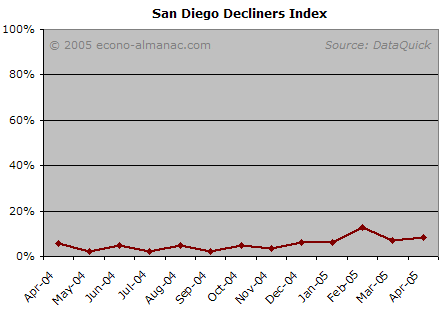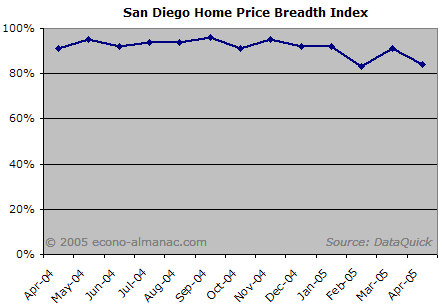My extensive rambling notwithstanding, the Econo-Almanac really has one primary purpose: to determine what’s going to happen to the San Diego housing market before it actually happens. With this goal in mind, I’ve developed two “price instability indicators” to identify declining pricing power before it actually shows up in the countywide median price figures.
The idea is that if the market starts to weaken substantially, it is unlikely to do so in a uniform manner. It could be the case that prices in some areas begin to fall significantly while prices in other areas remain stable or even increase. In such a situation, the countywide median price figures would understate the fact that pricing power had started to decline in some areas of the county. The two metrics described below will help to illuminate such price instability should it occur.
The Decliners Index
The Decliners Index is specifically designed to identify the scenario described in the above paragraph. This index measures the percentage of zip codes whose year-over-year median price has declined by 5% or more. Due to the small sampling size of individual zip codes, there will always be some zip codes whose median price in a given month happens to be 5% lower than the same month a year prior. This is statistical noise.
However, if this index starts trending up strongly, we’ll know that there has been a real decrease in pricing power even if the median price remains stable. Should this situation occur, we will get a real head start on the general market. But there is apparently plenty of time before that happens, as the market is thus far very stable:

The mild uptrend in this chart is explainable by the fact that prices had huge y-o-y appreciation numbers in 2004, working their way down to a 7.5% y-o-y increase last month and resulting in continually less margin for error. In other words, prices are quite stable throughout the county at this time and very few, if any, zip codes are experiencing downward pressure.
The Home Price Breadth Index
The Home Price Breadth Index is a more general tool to be used to look for changes in broad price strength. I explained the concept of breadth in my article on Market Indicators:
Breadth is a common stock market indicator, essentially measuring the number of advancing stocks against the number of declining stocks in a given index. The purpose of this measurement is to give an indication of broad market strength that would not be apparent from the stock index price itself.
As an example, let’s take the Dow Jones Industrial Average, which consists of 30 stocks (and let’s pretend for the sake of this simple example that they are all equally weighted in the index). Imagine if one of the companies suddenly declared bankruptcy and their stock dropped to 0 in a single day. The remaining companies in the index, however, did ok, each rising by 1%.
Overall, the DJIA will have dropped by about 2.5%, and just by looking at that figure you’d think the market had a bad day. However, the market didn’t actually have a bad day—one stock got hammered while the rest appreciated nicely. This is where the breadth measurement would come in. The fact that 97% of Dow stocks actually rose on this theoretical day would indicate that the market was actually doing better than the -2.5% reading would suggest.
Market breadth, then, is an alternative measure of price movements that supplements the overall price averages in order to give the observer a better idea of what’s going on in terms of pricing power.
Price breadth can be used with real estate just as it can be used with stocks, mostly to look for “divergences” like those described above, where the overall price index moves one way and the breadth index moves another way. The Home Price Breadth Index, which measures the number of zip codes with positive year-over-year changes in median price, could be a very useful tool, depending on how things play out. But for right now it’s just showing us that things remain pretty sedate:

Almost all zip codes continue to show appreciation, which reinforces the Decliners Index in suggesting that prices have flattened out countywide and that at this time there is little downard movement in home prices.
These Could Get Interesting
Nothing earthshattering is appearing in these metrics yet, but as I said above, they may provide a good “warning signal” should the less robust areas of San Diego start to feel pricing pressure. Conversely, a continued stability in the indices would indicate that San Diego housing, despite declining sales and flattening prices, is not under immediate threat of a decline. We will definitely watch both these indicators carefully each month.
